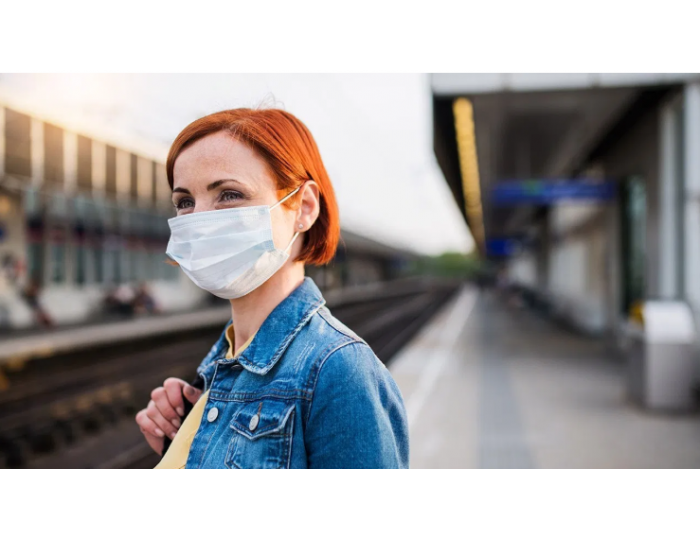Face Masks May Be Irritating Your Skin — How to Stop It

- Wearing a mask frequently can cause “maskne,” acne that is caused because the mask traps dirt and oil in pores.
- Mask wearing can also cause skin conditions such as miliaria and rosacea.
- Emollient, moisturizer, and prescription medications can help control maskne.
While acne is one trigger for maskne, Freidman said maskne may be a bucket term for a few conditions caused by wearing a mask.
Acne mechanica
Physical manipulation and pressure of a mask on the skin triggers acne.
“[With] the combination of friction, occlusion, and emotional stress of COVID-19… you have a perfect recipe for acne. Being a chronic inflammatory disease resulting in chronic skin barrier disruption, any stress on the skin or system overall can exacerbate this condition,” Friedman said.
Kraffert agrees, noting that stress is known to trigger facial flares of acne, eczema, seborrheic dermatitis, and rosacea.
“The pathways by which stress leads to these conditions is not entirely understood, but hormonal responses to stress may play a role. Mask wearing tends to worsen skin maladies. Together, stress and masks act synergistically to worsen facial skin disorders,” he said.
Miliaria
Also known as heat rash, miliaria can result from occlusion and sweat under the mask.
“Mask wearing leads to local alteration of the skin microbiome. With mask use, the covered skin is subjected to elevated CO2 levels, increased humidity, higher temperatures, and more bacteria and microorganisms from the mouth and respiratory system,” said Kraffert.
Unlike acne, which is more immunologically complicated, Friedman said miliaria directly results from the immune system responding to trapped dead skin cells, bacteria, and sweat salts in the openings of the skin where they don’t belong.
Rosacea
In addition to triggering acne flare-ups, Kraffert said alteration of skin microbiome by masks can worsen or trigger rosacea, perioral dermatitis, as well as seborrheic dermatitis, a dandruff-like facial redness with scaling.
While certain features of rosacea can mimic acne (papulopustules), Friedman said rosacea is different.
“Rosacea is a unique chronic inflammatory disease that results from skin barrier dysfunction, an overactive local immune response, and hypersensitive nerves around the blood vessels causing them to widen persistently, resulting in chronic facial redness. The same issues arise with wearing a mask all day in terms of disease exacerbation,” he said.
Here are a few ways to care for your skin while wearing a mask.
Apply emollient
Skin irritation with masks is most common along the bridge of the nose and central cheeks, where the flexible nosepiece is secured into place.
Friedman said this can be minimized by using a thicker emollient, such as Aquaphor, in the area to augment skin barrier function and provide lubrication for the junction of the mask with the skin.
Moisturize
Kraffert recommends lighter consistency moisturizers, ideally with anti-acne ingredients, such as retinol and purified nano-sulfur.
Friedman agreed, noting that one of the central issues that arises from wearing a mask all day is skin barrier injury.
“For diseases like acne and rosacea, this both instigates and propagates the abnormal inflammatory response. So, first things first, restoring that skin barrier is key. This means applying an oil-free moisturizer to damp skin multiple times a day,” he said.
Next, he said, is regulating inflammation and slowing down skin turnover.
“When the skin is inflamed, it makes itself too quickly, which in the setting of acne is even more problematic, as this can result in clogged pores, further worsening the condition. Topical retinoids are ideal for this, and there is one over-the-counter called Differin Gel .1 percent,” he said.
Because all retinoids can be drying and irritating when you first start using them, Friedman said to ease into using them by applying a pea-sized amount to the entire face and dry skin every other night for several weeks.
Cleanse and exfoliate
When you remove your mask, Kraffert said to gently cleanse and exfoliate your face.
Also, making it routine to clean masks once you take them off is recommended by the
“Certainly, the buildup of oil, dead skin cells, and other debris can be irritating to the skin among other things. More importantly is external exposures (i.e., particulate matter that hits the outside of the mask, which is protecting you. This needs to be cleaned,” said Friedman.
Use prescription medications
For more moderate to severe exacerbations, there are prescription medications your dermatologist can prescribe via telehealth, if on-site visits are restricted.
Friedman said ignoring conditions can lead to more severe skin problems.
“Persistent irritant contact dermatitis increases the risk for skin infection, and constant rubbing and irritation can elicit a herpes cold sore outbreak in those that get them, but I do not see this being the biggest and most persistent issue. Chronic inflammation can lead to long-standing skin discoloration, called post-inflammatory pigment alteration, especially in darker-skinned individuals. We have some, but no amazing treatments for this disfiguring outcome, which can be quite disabling,” he said.
